
Venezuela surpassed fifty percent in monthly inflation rates in 2017 and it has gone over that number many times since. But for the last seven months the monthly price increase has been lower. If it continues this way, it could declare itself hyperinflation free in January 2022. Will it do it with elections coming up?
By Caracas Chronicles – Marianela Palacios
Sep 7, 2021
Venezuela could break another record in 2022, and not an Olympic one, but rather an economic one and an infamous one at that: the most prolonged hyperinflation in modern history.
We’ve been in a hyperinflation cycle for 45 months and if we can’t manage to keep the monthly price increase below fifty percent in the upcoming months, we’ll dethrone Nicaragua in 2022.
The current historic champion, the Nicaraguan hyperinflation, went on for 58 months: from June of 1986 until March of 1991, according to research by economists Steve Hanke and Nicholas Krus, published in 2012 with backing from the Cato Institute.
Right now, things aren’t looking too bad. So far in 2021, Venezuela has managed monthly inflation rates below fifty percent, since in the first seven months, the price hike slowed down noticeably: 46% in January, 33% in February, 16% in March, 24% in April, and 28% in May, according to data released to date by the Banco Central de Venezuela (BCV). According to the Observatorio Venezolano de Finanzas (OVF), June registered 6.4% – the lowest rate since 2017 (one digit) – and 19% in July.
These monthly price increase rates are huge if you compare them to any normal economy in the world, but for Venezuelans, they seem small compared to the monthly inflation peaks we’ve had since 2017 when the hyperinflation cycle began in Venezuela: 55.6% in 2017; 127.7% in 2018; 196.8% in 2019, and 77.5% in 2020.
For a country to be considered free of hype-inflation, according to the thesis by economist Phillip D. Cagan, it must go below fifty percent in monthly inflation rates for twelve consecutive months.
Nicolás Maduro’s regime is trying to stop inflation by keeping the legal reserve requirements which dried the banking system’s liquidity, bringing back into play price controls and trying to favor national production by lowering almost 600 tariff lines.
Experience tells us that the first measure could help, but the second and third would most likely lead to shortages, as a result of low production capabilities by the national industry (located at around 10 and 20%); and an inflationary upturn, because many of the imported goods which were lining the market that was duty-free and free of tax, will now have to pay those fees again.
Furthermore, since prices tend to go up in November and December, because of a higher cash flow during the holiday season, Venezuela runs the risk of ending its streak and having inflation rates of 50% or more.
The same thing happened in 2020: monthly inflation rates ranged between 13 and 40 percent for ten straight months last year, but in December it went up to 77.5%, according to the BCV.
You also have to take into account that, because of the electoral stage expected for November, it’s very likely that the government will increase the number of bonuses and benefits in order to win votes and it’s also foreseeable a minimum wage increase for the fourth quarter of the year. This additional infusion of money, in a system where the offer is limited, usually leads to high price increases in the market.
Public Services Went Up 2,000 Percent
Nicolás Maduro’s administration will go down in history not only as the one where the GDP was reduced by 8% (the Gross Domestic Product is the main macroeconomic indicator used to measure the evolution, productivity, and health of any economy), but also as the period during which Venezuela suffered the world’s highest inflation rates for almost an entire decade.
Since 2017, the average annual inflation rate of advanced economies hasn’t gone above 2%, and in emerging or developing economies it’s 6%. In 2018, according to official data released by the chavista administration, Venezuelan inflation was 130,060%; in 2019 it was 9,585.5%; and in 2020 it was 2,959.8%.
These numbers are lower than the ones registered by international and national independent bodies, but they still recognize there’s hyperinflation since 2017. The Instituto de Investigaciones Económicas y Sociales de la Universidad Católica Andrés Bello (IIES UCAB) estimates that Venezuelan inflation will close at 1,667% in 2021.
Only this past year, public services in the country have raised their fees in over 2,000%, says economist Sary Levy, member of the Centro de Divulgación del Conocimiento Económico para la Libertad (CEDICE).
…
Read More: Caracas Chronicles – Heading to the longest hyperinflation in history
…


